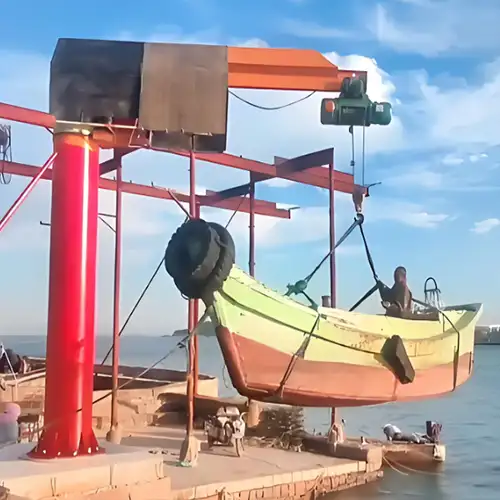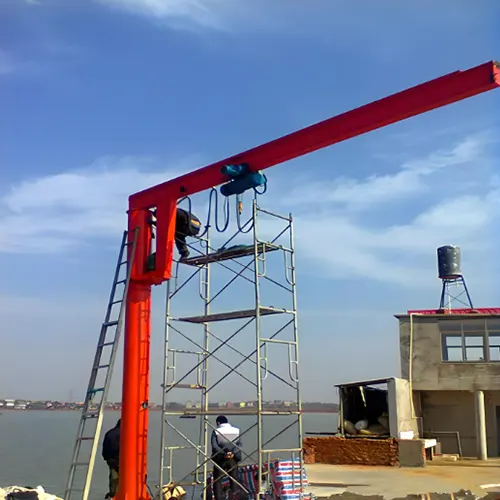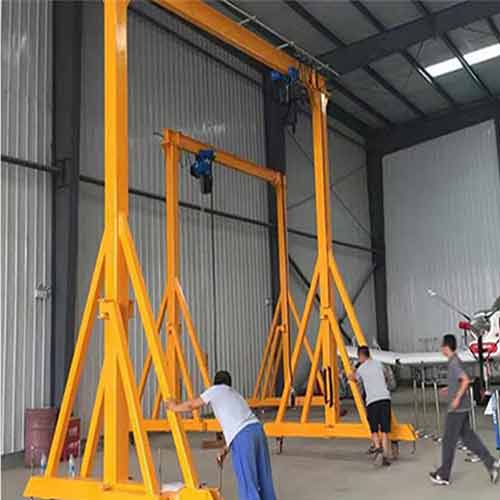Floor Mounted Jib Crane 5 Ton for Small Boat Handling at Port
5 ton jib crane for small boat handling. Reliable floor-mounted jib crane lifting boats up to 5 tons with smooth rotation, ideal for marinas and boatyards
Category: Floor Mounted Crane
Your Trusted Overhead Crane Manufacturer & Supplier
Floor Mounted Jib Crane 5 Ton for Small Boat Handling at Port
Introduction
What is a Pillar Jib Crane?
A pillar jib crane is a type of localized lifting equipment mounted on a fixed vertical column. The arm (or jib) rotates horizontally, allowing for flexible movement of loads within a circular working area. It's commonly used where you need quick, repeated lifting over a defined space—without the need for a full overhead crane setup.
- The crane is fixed directly to the floor or foundation and takes up minimal space.
- Its rotating arm can usually cover 180° to 360°, depending on the model.
- It's powered by either manual or electric slewing, and lifting is done via a wire rope or chain hoist.
Why 5 Tons? The Sweet Spot for Small Boat Lifting
For small boats—think fishing boats, rescue boats, or leisure craft under 30 feet—5 tons is more than enough to handle the lifting safely. Many boats in this category weigh between 1.5 to 4.5 tons when fully loaded with gear, fuel, and equipment. A 5-ton crane gives just the right balance between capacity and flexibility, with a safety margin built in.
- Covers a wide range of boat sizes: rigid-hull inflatables, small cabin cruisers, speed boats, and utility boats.
- Ensures safe lifting even when water, debris, or gear adds extra load unexpectedly.
- Offers peace of mind during hoisting, especially in windy coastal conditions.
Where Floor Mounted Jib Cranes Are Used
You'll often find 5-ton pillar jib cranes installed in places where boats are moved regularly, and space is tight. Whether it's lifting a boat out of the water for cleaning or putting it on a trailer for transport, these cranes simplify the process and reduce manual work.
- Marinas – for seasonal lifting or maintenance of customer boats.
- Boatyards – where boats are repaired, cleaned, painted, or stored on land.
- Coast Guard stations or rescue units – for rapid deployment and retrieval.
- Boat factories – where hulls, engines, and gear are installed during assembly.

For small boat handling, floor moounted jib cranes are commonly installed at ports, marinas, and boatyards. They are used to launch and retrieve boats, especially in tight spaces near the water. These cranes are also found in shipyards for maintenance work, fishing harbors for loading and unloading equipment, and private resorts or clubs for guest boat operations. In addition, they are used by coastal rescue stations for quickly deploying small patrol boats, and in boat manufacturing facilities to move vessels during production or inspection. Their compact design and easy rotation make them ideal for localized lifting in marine environments.In short, if you're working around water and need reliable lifting without installing a massive gantry, the 5-ton pillar jib crane is a straightforward and practical tool.
Key Features of the 5 Ton Floor-Mounted Pillar Jib Crane
Reliable 5-Ton Lifting Capacity with Safe Working Margin
The floor-mounted pillar jib crane is engineered to safely lift boats up to 5 tons. In the real world, this covers most small fishing boats, patrol boats, and utility craft—even when they're loaded with fuel, gear, or tools. The direct mounting on the concrete foundation gives it extra stability and confidence when operating near water.
- True 5-ton working load capacity, not just a theoretical limit.
- Ideal for boats weighing between 2 to 4.5 tons when fully equipped.
- Safety factors built into both the structure and the hoist mechanism.
180° to 360° Slewing—Dependable Ground-Level Control
Because the crane is mounted directly on the floor, it allows for a clean and uninterrupted slewing motion. Depending on your site conditions, you can choose a half-circle (180°) rotation or full-circle (360°) coverage, giving complete flexibility when lifting from the dock and turning toward trailers or service platforms.
- 180° slewing for installations near walls or other fixed structures.
- 360° slewing for open yard or dockside setups.
- Manual rotation is smooth and easy for shorter arms; electric slewing is available for longer arms or heavier use.
Customizable Lifting Height and Jib Arm Reach
When lifting boats from water to dock or trailer, height and reach are crucial. A floor-mounted design means there's no overhead restriction from ceilings or beams. This gives you freedom to customize both lifting height and arm reach for the job.
- Common lifting heights: 4 to 8 meters (custom heights available).
- Typical outreach (jib arm length): 3 to 6 meters.
- Floor-mounted setup allows taller vertical clearance compared to wall-mounted options.
Space-Efficient Installation for Tight Dockside or Yard Areas
Since the column is mounted to the floor, the crane doesn't interfere with nearby walls, walkways, or equipment. It's a good fit for marinas and boatyards where space is tight and every meter counts.
- Base column usually requires a concrete pad (around 1.2m x 1.2m x 1.5m deep depending on the load and soil).
- Doesn't need a runway or track—fully independent structure.
- Allows forklifts or trailers to move freely around the base.
Built Tough for Outdoor and Marine Use
The floor-mounted pillar jib crane is designed for harsh environments. Whether installed near saltwater or exposed to rain and UV, it holds up well. Most models are treated with marine-grade paint or optional galvanization to resist rust and wear.
- Steel structure coated with epoxy or polyurethane anti-corrosion paint.
- Hot-dip galvanization available for extra protection in coastal areas.
- All exposed fasteners and hoist components are either stainless steel or protected for outdoor use.
Simple, Flexible Operation with Control Options
Operating a floor-mounted jib crane is straightforward. The controls are designed for ease and safety, especially when lifting boats that are floating or being guided into position manually.
- Basic models use a wired pendant control for hoisting and lowering.
- Remote control units are available for safer distance operation—especially handy when guiding the boat from the dock.
- Manual slewing is standard for short arms; electric slewing can be added for frequent or heavy rotation tasks.
- Comes with standard safety features like limit switches, emergency stop, and overload protection.
Design Considerations for Small Boat Handling
Stable Base—Foundation Comes First
When handling boats, especially over water or on uneven dock surfaces, the crane's stability matters more than anything. A floor-mounted pillar jib crane must be anchored to a reinforced concrete foundation that matches both the load rating and rotation force. Skipping proper foundation planning can lead to vibration, tilt, or even structural failure over time.
- Typical foundation depth: 1.2 to 1.5 meters with heavy-duty anchor bolts.
- Reinforced concrete pad recommended for full 360° slewing setups.
- Site conditions (soil type, moisture, slope) should be assessed before installation. Check Pillar Jib Crane Installation & Floor Foundation Construction with Pictures and Steps , or check the Youtube Video on Small Jib Crane Installation: Cost-effective Pillar Jib Crane 2T, 3T, 5T for Small Business Owners
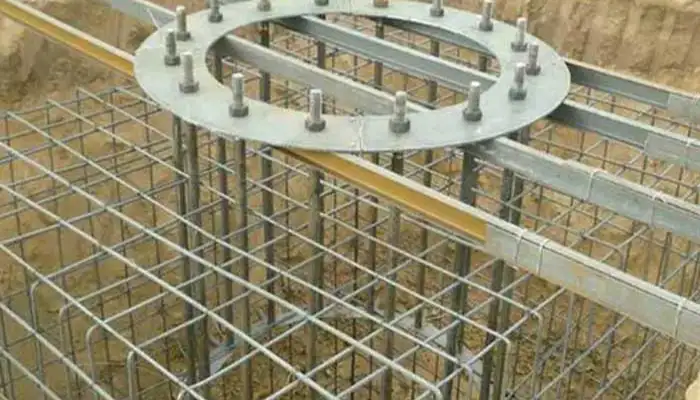
Tip: If your dockside area is limited, make sure the foundation layout doesn't interfere with underground drainage or utilities.
Fits Boats of Various Sizes and Designs
Boats come in all shapes—flat-bottomed, V-hull, inflatable, and even catamaran. The crane must accommodate different lifting points and center-of-gravity positions. You'll also want enough lifting height to clear obstacles like handrails or mounted equipment.
- Check the boat's lifting weight with gear, not just empty hull weight.
- Jib outreach must match the horizontal distance from water to trailer or cradle.
- Lifting slings or spreader beams should be adjustable for odd-shaped boats.
Hoist and Trolley: The Real Workhorses
The hoist system makes or breaks your crane's performance. For small boat handling, a wire rope hoist is often preferred for smoother vertical lifting and higher lifting speeds. The trolley must also move smoothly along the jib arm without jerks, especially when positioning the boat carefully.
- Use a dual-speed or variable-speed hoist for better control.
- Trolley should match the curvature of the jib arm (manual or electric available).
- Hoist braking system should allow gradual stops to avoid sudden boat swing.
Tip: For fiberglass or delicate hulls, consider using soft slings with corner protection to prevent surface damage.
Rotation: Make It Easy to Swing and Position
One major advantage of a floor-mounted pillar jib crane is its ability to rotate a boat into position. This matters a lot when maneuvering over trailers or into tight storage spaces. The slewing mechanism should be easy to operate without requiring excessive manual effort.
- Manual slewing is fine for short arms and light usage.
- Electric slewing is recommended for longer arms (5–6 meters) or frequent use.
- Rotation limiters or stops can be added to avoid hitting nearby objects.
Built-In Safety Features
Boat lifting comes with real risks—load shifting, sudden wind, or uneven weight distribution. That's why the crane should come equipped with key safety systems as standard. You don't want to find out you're missing these halfway through a lift.
- Limit switches to stop the hoist before it overwinds or over-lowers.
- Overload protection to stop lifting when weight exceeds rated limit.
- Emergency stop button to shut off operation instantly if something goes wrong.
- Optional: Audible alarm or flashing light during operation for added awareness.
Installation and Site Requirements
Solid Ground and Strong Foundation—No Cutting Corners Here
The floor-mounted pillar jib crane depends entirely on the strength and stability of its foundation. You can't just bolt it to paving stones or old concrete. It must be anchored into a reinforced concrete base that can handle not only the weight of the boat but also the force of slewing under load.
- Minimum recommended foundation: 1.2m × 1.2m × 1.5m deep, with steel reinforcement.
- Use heavy-duty anchor bolts designed for dynamic load applications.
- Let concrete cure fully (at least 7–10 days) before mounting the crane.
Tip: Always review local soil conditions. Loose or sandy ground near water may require deeper footing or added reinforcement.
Electrical Setup: Know What Power You Need
The crane's hoist, trolley, and optional electric slewing system need a reliable power supply. This isn't the time to guess. Voltage mismatches or underpowered setups can lead to poor performance or even motor damage.
- Standard power requirement: 380V, 50Hz, 3-phase (confirm local availability).
- Include weatherproof isolator switches near the crane.
- Wiring must be suitable for outdoor, marine environments—preferably rubber-insulated or armored cables.
Tip: If your boatyard has limited power access, check if a diesel generator or solar backup is practical for occasional lifting jobs.
Designed for Harsh Outdoor Use
Marinas and boatyards are rough environments—sun, salt, rain, and wind don't go easy on steel structures. The crane must be finished to handle it all. Rust can creep in fast if coatings or seals are neglected.
- Use hot-dip galvanized structure for saltwater zones.
- Marine-grade epoxy paint is a good alternative where galvanizing isn't available.
- Electrical boxes should be rated IP55 or higher for outdoor installation.
Tip: Install the crane in a spot with natural drainage to avoid standing water around the base.
Plan for Movement—Not Just the Crane, But the Boat
It's easy to forget that installing a crane isn't just about lifting—it's also about what happens before and after the lift. The crane must be placed where boats can swing freely, be lowered onto trailers, or moved to a wash area.
- Ensure full slewing range without hitting other structures or equipment.
- Keep at least 1.5 to 2 meters clearance around the base for operator movement and sling handling.
- Consider wind conditions—an open area near the coast may need a wind lock or limit stop.
Operational Benefits
Launch and Retrieve Boats Faster
With a 5-ton floor-mounted jib crane, the whole lifting process becomes quicker and more controlled. No more waiting for forklifts, manual hoists, or makeshift ramps. Whether you're putting a boat into the water or pulling it out for cleaning, it's all done in a matter of minutes.
- Lifts small boats in 3–5 minutes, depending on setup.
- Reduces downtime between service jobs.
- Ideal for marinas with high turnover or multiple daily lifts.
Less Physical Strain, More Safety
Dragging boats across the yard or using chains and blocks is not only exhausting—it's dangerous. This crane eliminates much of the manual effort and risk of injury. Operators can stand clear and guide the lift remotely if needed.
- Eliminates need for manual hoisting, especially on slippery or uneven surfaces.
- Keeps staff out of danger zones during lifting and slewing.
- Reduces risk of boat damage due to uncontrolled movement or dropping.
One Crane, Many Boat Types
From small rigid-hull inflatables to fiberglass cruisers and aluminum skiffs, the 5-ton jib crane handles them all. You just need the right slings and lift points. The adjustable reach and rotation allow it to serve various boat sizes without modification.
- Works with V-hulls, flat-bottom boats, and more.
- Easily adapts to custom slings or lifting beams.
- Can also be used for engines, equipment, or cradles.
Low Fuss, Low Maintenance
Once installed, these cranes are straightforward to operate and maintain. With occasional lubrication, inspection, and surface cleaning, they can run for years with minimal attention.
- Fewer moving parts than overhead or gantry systems.
- No need for tracks, runways, or overhead beams.
- Spare parts for hoists and controls are widely available.
Conclusion
Why the 5 Ton Floor-Mounted Pillar Jib Crane Works So Well for Small Boats
When it comes to lifting small boats efficiently and safely, the 5-ton floor-mounted pillar jib crane gets the job done without overcomplicating things. Its strong base, full rotation, and customizable reach make it perfect for marinas, boatyards, and service docks with limited space. It's built to last in tough marine conditions, and it allows for fast, controlled movement of boats with minimal manual effort.
- Lifts up to 5 tons comfortably—ideal for most utility and service boats.
- Allows precise control when transferring boats to trailers, cradles, or drydock.
- Floor-mounted base keeps the crane stable and out of the way of other operations.
- With the right corrosion protection, it holds up well in outdoor, coastal environments.
A Few Practical Recommendations for Buyers and Operators
If you're considering a jib crane for your dockside operations, take time to review your actual lifting needs—not just capacity, but reach, height, and usage frequency. Also, plan the installation with care. A properly poured foundation and smart crane positioning will save headaches down the road.
- Choose electric slewing and remote controls for frequent or solo operations.
- Make sure your foundation design fits local soil and wind conditions.
- Match sling and spreader setup to your most common boat shapes.
- Don't forget to include space for safe access and boat movement around the crane.
Let's Help You Find the Right Setup
Every site is different, and we can help you find the right configuration—arm length, height, rotation range, and corrosion protection. Whether you're lifting once a day or twenty times a shift, we'll recommend the best setup for your workflow and budget.
Contact us today for a free quotation, technical consultation, or to discuss customization options for your marina or workshop. Just let us know your boat sizes, lifting requirements, and site layout—we'll handle the rest.Click to learn more 5 ton jib crane and specifications, and more on jib crane capacity and tonnages.
Related Products
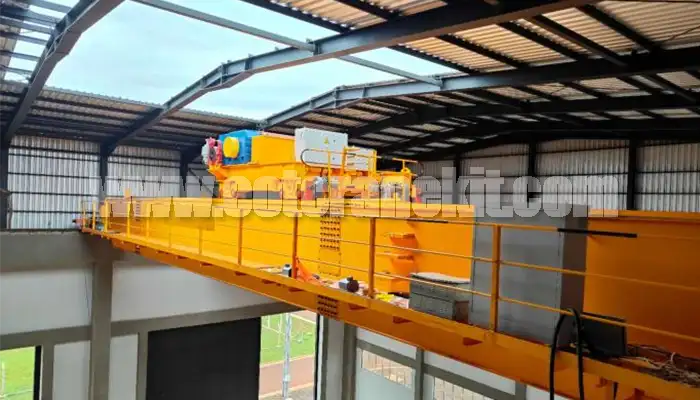
Latest project
150 Ton Overhead Crane Installation Feedback – Paraguay Case
QDX 150 ton overhead crane in action in Paraguay. Installation photos, video, and client feedback show performance, safety, and heavy-lifting efficiency.
Free consultation to Confirm Parameters & Specifications and Get
Latest Crane Price & Crane Rate.
- Types of overhead cranes : _______?
- Optional: Overhead travelling crane, goliath gantry crane,Slewing jib crane, Single girder or double girder crane,small portable crane or kbk crane, etc.
- Capacity of overhead crane: _______?
- Optional: 0.25ton, 0.5 ton, 1 ton, 2 ton, 3ton, 5 ton, 10 ton,15ton, 20ton, 25 ton, 30ton,35ton, up to 550ton, etc.
- Crane span & lifting height : _______?
- Crane travelling length : _____?
- Control of overhead crane:_______?
- Optional: pendant/ remote/cabin control
- Voltage supply of overhead crane:_____?
- Eg,: 380V50/60HZ,3Phase or others,etc.
- Application/usage of crane:_______?
- Eg,: Steel mill, ,injection mold, cement,stone, concrete,granite, general manufacturing, etc.
Just leave a message via the contact form and our hoist and crane engineer will contact you with in 24working hours.
Get In Touch
